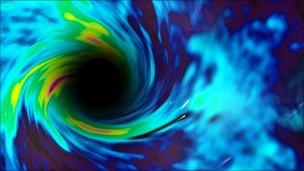Spinning black holes 'twist light'
- Published

The group's method could prove once and for all that a supermassive black hole sits at our galaxy's centre
Researchers have proposed a means to spot rotating black holes.
The idea may provide the first unique signature of black holes, which - true to their name - have never been seen.
The approach, reported in Nature Physics, external, relies on a property of light called its orbital angular momentum.
The roiling nature of the fabric of space-time around spinning black holes should impart a "twist" in this momentum which could be detected here on Earth, the researchers say.
Light particles known as photons carry two kinds of momentum - a kind of energy carried in motion - but only one of them is familiar.
"If we take the Earth as an example, it spins around its own axis in about 24 hours - that's its spin angular momentum, and it also moves in orbit around the Sun - that's its orbital angular momentum," explained Bo Thide, a co-author of the paper.
"Photons can carry both," he told BBC News.
The spin angular momentum of photons manifests itself in the familiar phenomenon of polarisation - an effect that some sunglasses and even 3D glasses exploit.
But orbital angular momentum is trickier, and though it was predicted by the father of electromagnetic theory James Clerk Maxwell, it took until 1992 for experimentalists to find a way to manipulate it.
'That's relativity'
Now Professor Thide, of the Swedish Institute of Space Physics, and his colleagues have shown how the unique conditions around a spinning black hole could also impart orbital angular momentum to passing light.
"Around a spining black hole, space and time behave in such an odd way; space becomes time, time becomes space, and the whole space-time is acutally dragged around the black hole, becomes twisted around the black hole," Professor Thide explained.
"If you have radiation source... it will then sense this twisting of spacetime itself. The light ray may think that 'Wahey, I'm propagating in a straight line', but if you look at it from the outside, you see it's propagating along a spiral line. That's relativity for you."

The light's "phase" would show a characteristic pattern - that astronomers have never thought to look for
The idea that spinning black holes could leave their imprint on passing light was first put forward by Martin Harwit of Cornell University in 2003 in an article in the Astrophysical Journal, external.
Professor Harwit presumed the light would be coming from some point beyond the black hole and simply passing nearby, and his calculations showed the effect would be minimal.
Professor Thide's team have now shown that the light emission from the swirling disc of material hypothesised to be around black holes, which emits intense light, would show the imprint more profoundly - enough to be spotted by the biggest telescopes on Earth, if their operators knew what they were looking for.
Champagne, no supernova
The great masses that sit at the centres of galaxies including our own Milky Way are by consensus presumed to be black holes, and if they are, are likely to be spinning. So a signature of light that can reveal spinning black holes is a potentially powerful tool in discovering how our galaxy is put together.
"While this effect has been known to theorists for some time, it has been regarded as obscure and of no practical importance," said Saul Teukolsky, an astrophysicist and black hole expert at Cornell University in Ithaca, US.
"What is exciting here is the prospect it might be used to measure the spin of the black hole at the center of our galaxy - the measurement will be difficult, though," he told BBC News.
In fact, to put the method into practice, only the very largest telescope arrays can be used. Professor Thide said that the Very Large Array in New Mexico, and the coming Square Kilometer Array and Atacama Large Millimetre Array telescopes could be the proving grounds for the idea.
"You would have to modify (the telescope arrays) slightly - probably only through software, and then you combine the signals in a way that's never been done before," he explained.
"If we are lucky, we should see the twisted light stand out, and then we open a bottle of champagne or two."
- Published25 August 2010